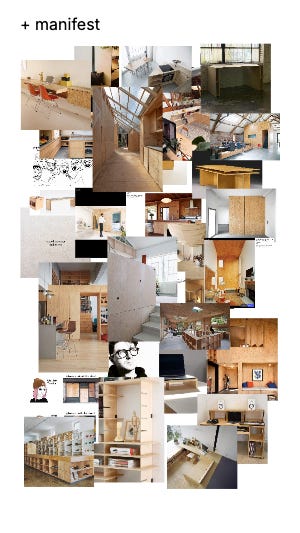Designing a Manifestation Tool, for All of You Pinterest Girlies
with inspiration from are.na, cosmos, and pinterest.
SurelyWork.com cost me (and others) over $100K in development. That project taught me a lot about building for creators, but it also made me realize just how inaccessible and expensive tech can be when you don’t code. Fast forward to now—and building +Manifest using Vercel v0 has completely changed the way I think about launching tools, SaaS, and ideas as a non-coder.
For the past few weeks, I’ve been obsessed with simplifying creative workflows—specifically, how to streamline inspiration gathering in a way that feels intuitive and beautiful. Well, that’s kind of a lie. Truly, I just saw a girl walking down the street with a manifestation board and I wanted to see if I could figure out how to build an easy generator for all those people on Pinterest.
Lastly, I really want y’all to know this isn’t an ad of any sort—I’m simply just amazed and obsessed with this new tech.
The Problem: Too Many Tabs, Too Many Steps
Like a lot of designers and creative directors, I’ve always defaulted to Figma or Are.na when curating ideas (and now cosmos), but they each have their friction points. Figma is great for composition but can feel like overkill for quick inspiration dumps—and gen pop doesn’t know how to use it. Are.na is excellent for organizing, but it lacks the visual fluidity I wanted. Photoshop? Yes, great for the drag and drop—but many people aren’t paying $70+ a month for Adobe anymore, and definitely not those Pinterest boarding their favorite mug slogans.
We need something simpler—just a place to drop images, reference ideas, and iterate with a few clicks.
I also noticed a lot of Pinterest girlies downloading images and scrambling between different phone apps just to create a simple moodboard. That felt like a perfect use case—solving a quick problem that usually takes 30 minutes and cutting it down to a few seconds. But more than that, I didn’t necessarily build this tool because I personally needed it—I built it to test the full limitations of something I had never used before, trying to solve someone else’s problem. It was an experiment in pushing no-code tools to their limit, while also seeing if I could create something actually useful for others.
Enter Vercel v0: No-Code Web Development
I’ve messed around with Webflow, Cargo, Squarespace, and many more, but the learning curve always felt steep for someone who doesn’t code. Then I came across v0, which allowed me to quickly structure the site with minimal effort. I figured: Why not?
Turns out, it’s insanely powerful. You describe what you need, and it builds the structure for you—no manual HTML, CSS, or React required. For someone who primarily works in visual mediums, this meant I could focus on the design language instead of getting lost in technical execution.
Using Figma to Shape the Design
I started by sketching out a basic layout in Figma: minimal, grid-based, and flexible enough to evolve. My goal was to keep things clean and modular, with a neutral palette that wouldn’t compete with the content itself. Once I had the structure visualized, I used Vercel v0’s builder to generate the skeleton of the site. From there, it was just a matter of tweaking sections and refining the UI.
What Worked (And What Surprised Me)
Fast Iteration – In about 30 minutes, I had a working prototype. That’s unheard of. ChatGPT built a few worse iterations in about 2 hours.
No-Code Freedom – I didn’t have to rely on a developer or get stuck troubleshooting syntax.
Nothing Could Do This A Year Ago – While the deployed version of +Manifest didn’t fully work with fetching link URLs as I originally intended, it still allows users to upload images and play with layout without needing Photoshop, making it far more intuitive than other alternatives.
The Bigger Picture: No-Code for Real Tools
Building portfolios and informational pages is one thing, but creating legitimate tools? That’s a different level of game.
I have no idea what other tools I’ll make, but I do know that I’ll be looking into my other startup, SurelyWork. A project that previously cost over $100K in dev work—robbery, perhaps, I realize now. With these new tools, I might actually be able to rebuild SurelyWork and other creative tools into something new. And maybe this time, it won’t be centered around the gig economy but around creators themselves.
The Final Product
+Manifest is now live (manifestme.vercel.app), and it’s exactly what I wanted: a simple, aesthetic-first moodboarding tool. It’s still evolving, but the process of building it taught me that no-code tools are finally at a point where non-coders can bring ideas to life without barriers.
Would I use Vercel v0 again? 100%. Would I recommend it? If you’re someone who has ideas but lacks the technical skills to build them, this is a game-changer for MVPs. (minimum viable products)
📍Spot of the Week:
Laurel Bakery, Cobble Hill, NYC - This little bakery away from home opened about a year ago close to my girlfriends BK Heights spot and we stumbled upon it around that time. It’s top 10 best coffee shops for pastries that I’ve been to (world wide) and they carry coffee from SEY. Not good for sitting, great for grab and go.
👜 Purchase of the Week
Galvanized Wall Candle Holder, Lichen NYC - Known early for their design forward, vintage furniture collection, Lichen has started really diving in on their own designs. Phenomenal purchase that adds a nice accent to the room.
Thanks team. If you have any questions DM on IG.
J









